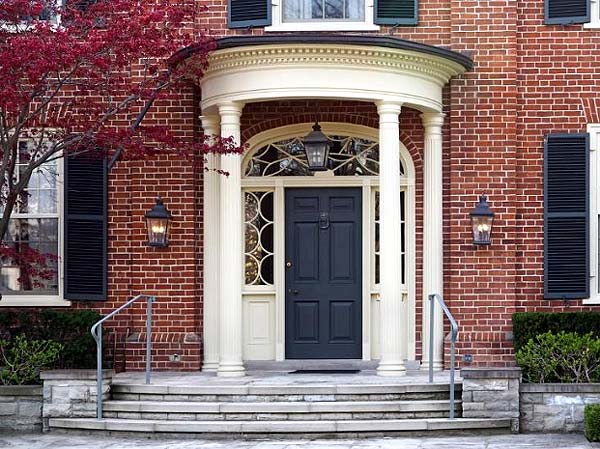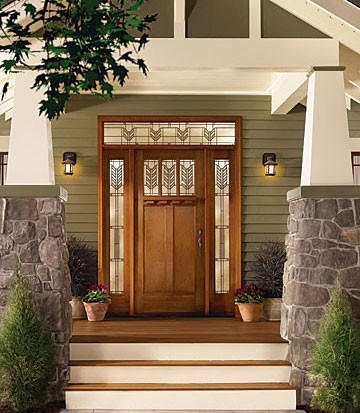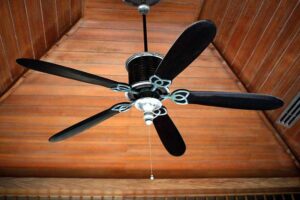Doors on your home are the gateway from the outside world and where you reside. They keep out the elements and keep in your desired environment. Exterior doors are super important because it is estimated to lose as much as 11% of your home’s energy through inefficient doors. Lowering utility costs requires more than just closing the door. There are several simple solutions to improve your home’s energy efficiency and save money.

Choose an Energy-Efficient Door Material
If you have older exterior doors or ones that just seem to let the outside air in constantly, think about replacing them. Older doors especially have a tendency to not be energy efficient, as technology has changed and so has the way we make doors.
Fiberglass doors are generally the most energy-efficient, up to four times more insulation properties than wood. Vinyl or steel doors are also good insulators. Wood is considered the least energy-efficient unless they are solid core doors that have a strong polyurethane foam in the interior like the wood doors at ETO Doors.
Doors with large glass panels are generally less energy-efficient due to the conductive properties of glass. They absorb the temperatures around them. Some higher-quality glass-paneled doors have special insulation or coatings on them to fight the poor conductive properties. These coatings help to save you up to 50 percent vs an uncoated glass door.
Caulk Gaps

Even the most energy-efficient door will not be enough if there are any gaps between your door and the frame. If the door isn’t perfectly aligned to the frame then this will cause a gap, a gap will let air pass through into or out of your home.
This usually happens because over time the door will shift slightly. All the heat you are generating to keep your home warm in the winter will just walk out the front door, literally.
If your exterior doors are hung properly, you can caulk around the frame, making a barrier to stop any drafts. This simple and cheap fix should cost no more than $10. Apply the caulk to gaps ¼ inch wide or smaller. If the space is larger than that, don’t worry. Simply buy a backer rod, like foam, and stuff the hole with that. Don’t forget to apply caulk on top.
Something to keep in mind while doing this is to only caulk non-moving parts, as the caulk will do nothing if it is being moved after it sets. Also, be sure to apply it to a clean surface. Any grime, old caulk, or dirt should be removed to ensure the tightest seal of your draft.
Weatherstripping
Weatherstripping is a very simple yet commonly overlooked way to save on utility bills. It is usually comprised of foam, rubber, felt or vinyl and is located between the door and the frame. This provides a cushion for when the door closes to keep it sealed. It comes in an adhesive that is very simple to apply and cheap to purchase.
Check to see if any existing weatherstripping is worn, cracked, dry looking, or ripped anywhere. If so, simply peel it off, clean the frame where it once sat, and apply the new weather stripping. Make sure to leave no gaps or the draft will remain.
Note, your door may be slightly harder to close with new weather stripping. This is normal. If it is too hard to close, try thinner weather stripping, although this problem isn’t common.
Adding Sweeps
Inspect for a gap under the door, and add a door sweep if you have space there. Door sweeps lower heating and cooling costs but has other perks as well such as keeping out moisture, dust, and insects.
There are two main kinds of door sweeps. “U” shaped ones that fasten to the underside of the door, and metal strips that are glued or nailed to the door bottom. Both are simple to install and can save you a lot of money in the long run.
Make Use of Your Curtains
Everyone tends to keep their curtains open all the time, but did you know that by doing so you are losing heat or AC? To make the most of your energy savings, keep the curtains closed in the hottest and coldest months. You might even want to consider purchasing some thermal-backed curtains to better aid them from letting in or out outside air.
Install Storm Doors
There are debates on whether or not storm doors are actually worth it to conserve energy. Storm doors that have thermal lining and double-paned glass are considered energy efficient, however. A logical and simple way to improve the efficiency of an existing storm door is to replace the screen with a glass pane to add another barrier to keep outside air out. This trick works on any door, but especially storm doors due to their nature of being designed to be energy efficient.
Aside from securing your home, the front door should be inviting to those who you welcome into your home. This year make sure you don’t invite in the cold through your exterior doors. Instead, remember these important energy-saving tips.



